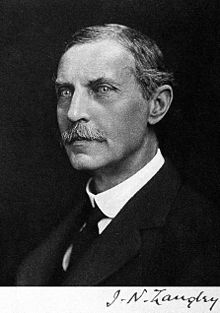John Newport Langley FRS (2 November 1852 – 5 November 1925) was a British physiologist, who made substantive discoveries about the nervous system and secretion.
John Newport Langley | |
|---|---|
 | |
| Born | 2 November 1852 Newbury, England |
| Died | 5 November 1925 (aged 73) Cambridge, England |
| Nationality | British |
| Alma mater | University of Cambridge |
| Known for | Autonomic nervous system Secretion |
| Awards | Royal Medal (1892) |
| Scientific career | |
| Fields | Physiologist |
| Institutions | University of Cambridge |
| Academic advisors | Michael Foster |
| Notable students | Walter Morley Fletcher Charles Sherrington Leon Orbeli |
| Notes | |
Life
editHe was born in Newbury, Berkshire the son of John Langley, the local schoolmaster, and his wife, Mary Groom. He was educated at Exeter Grammar School in Devon. In 1871 he won a place at St John's College, Cambridge, where he graduated MA before continuing multiple postgraduate studies, gaining several doctorates.
He spent his entire career at Cambridge University, beginning as a Demonstrator in lectures in 1875. He began lecturing in Physiology in 1884 and was awarded a professorship in 1903, succeeding Prof Michael Foster.[1]
He was elected a Fellow of the Royal Society in 1883 and later its vice-president. He was made an Honorary Fellow of the Royal Society of Edinburgh in 1916.[2]
Langley is known as one of the fathers of the chemical receptor theory, and as the origin of the concept of "receptive substance".[3][4]
In 1901, he advanced research in neurotransmitters and chemical receptors, working with extracts from adrenal glands. These extracts elicited responses in tissues that were similar to those induced by nerve stimulation.[5]
He coined the term "autonomic nervous system" (ANS) in 1898.[6]
He was the first person who put forward the concept of parasympathetic nervous system as a division of the ANS in 1921.[7]
He died in Cambridge on 5 November 1925, aged 73.
Publications
edit- The Autonomic Nervous System (1921)
- Elementary Experimental Physiology
Recognition
editA brass plaque to Langley's memory exists in Trinity College Chapel at Cambridge University.[8]
Family
editLangley married at St. Mary′s church, Montrose, on 10 September 1902 Vera Kathleen Forsythe-Grant (d.1932), third daughter of Frederick Grant Forsyth-Grant, of Ecclesgreig, Kincardineshire.[9]
References
edit- ^ "John Langley". 15 April 2016.
- ^ Biographical Index of Former Fellows of the Royal Society of Edinburgh 1783–2002 (PDF). The Royal Society of Edinburgh. July 2006. ISBN 0-902-198-84-X. Archived from the original (PDF) on 4 March 2016. Retrieved 10 March 2017.
- ^ Langley J.N. (1905). "On the reaction of cells and of nerve-endings to certain poisons, chiefly as regards the reaction of striated muscle to nicotine and to curari". J Physiol. 33 (4–5): 374–413. doi:10.1113/jphysiol.1905.sp001128. PMC 1465797. PMID 16992819.
- ^ Maehle A.-H. (2004). ""Receptive Substances": John Newport Langley (1852–1925) and his Path to a Receptor Theory of Drug Action". Med Hist. 48 (2): 153–174. doi:10.1017/s0025727300000090. PMC 546337. PMID 15151102.
- ^ Rubin, Ronald P. (December 2007). "A Brief History of Great Discoveries in Pharmacology: In Celebration of the Centennial Anniversary of the Founding of the American Society of Pharmacology and Experimental Therapeutics". Pharmacological Reviews. 59 (4): 289–359. doi:10.1124/pr.107.70102. PMID 18160700. S2CID 33152970.
- ^ The Autonomic Nervous System. Cambridge : W. Heffer & Sons, Ltd. 1921. p. 6.
- ^ Johnson, Joel O. (2013), "Autonomic Nervous System Physiology", Pharmacology and Physiology for Anesthesia, Elsevier, pp. 208–217, doi:10.1016/b978-1-4377-1679-5.00012-0, ISBN 978-1-4377-1679-5
- ^ "Trinity College Chapel - John Newport Langley".
- ^ "Marriages". The Times. No. 36872. London. 13 September 1902. p. 1.
Bibliography
edit- Katz, B. (1986). "Archibald Vivian Hill", Dictionary of National Biography, Oxford University Press, Oxford, p. 406